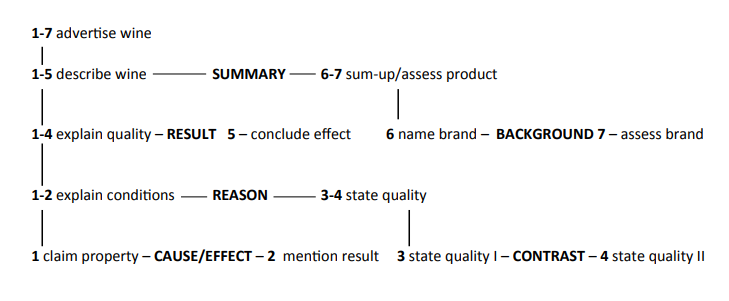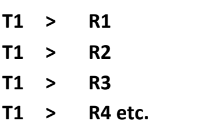ENGLISH LINGUISTICS II
1/34
Earn XP
Description and Tags
Flashcards about Coherence in text
Name | Mastery | Learn | Test | Matching | Spaced |
|---|
No study sessions yet.
35 Terms
Proposition
the main idea of a sentence — it tells who did what or what happened.(ore conceptual content) predicate+ argument
(Example: PERSON + ACTION or OBJECT + EVENT)
What a pity that the poor boy can’t cope with the horrible truth!
It is a pity that x.
The boy can’t cope with the truth.
The boy is poor.
The truth is horrible.
Propositional Analysis
A list of minimal meaning units showing which ones are directly related.
Our stony soil provides excellent drainage.
PROVIDE (SOIL = Subject, DRAINAGE = Object)
Discourse/Propositio Relations + types 2
Semantic-pragmatic connections between textual units.
(i.e. sentence/phrase)
Additive relations
Causal relations
Additive Relations (Discourse/Propositio Relations)
Coordinated structures relating to one another through addition, contrast, disjunction etc.
Gold is a precious metal. It is prized for two important characteristics. (addition)
Causal Relations(Discourse/Propositio Relations) + types 4
Subordinated structures expressing more specific logical relations, e.g. reason, consequence, condition etc.
Our stony soil provides excellent drainage. There is never too much water around for the vines to soak up. (consequence)
reason
means
consequence/purpose
concession
Reason (Causal Relations)
cause for action
c) I opened fire.b) I saw the enemy approaching.
Means (Causal Relations)
Instrument to achieve a goal.
d) I beat off the attack.c) I opened fire.
Consequence (Causal Relations)
Result of an action.
c) I opened fire.d) I beat off the attack.
Purpose(Causal Relations)
Aim of an action.
c) I opened fire.d) I beat off the attack.
Concession(Causal Relations)
Cause without logical consequence.
d) I beat off the attack.b) I saw the enemy approaching.
Rhetorical Relations + types 6
Relations with the intention of bringing about a change in opinion, position, or behavior of readers or listeners.
evidence
justification
conclusion
contrast
motivation
solution
Evidence (Rhetorical Relations)
Providing evidence
Air pollution got worse in the city. Trees are covered in fine dust.
Justification (Rhetorical Relations)
Providing justification.
I ate up all the cake. No one seemed to want any more.
Conclusion (Rhetorical Relations)
Drawing a conclusion.
The bike is gone. He must already have left.
Contrast (Rhetorical Relations)
Showing contrast.
This beer here has lots of fizz. The stuff yesterday was smoother and didn’t sparkle that much.
Motivation (Rhetorical Relations)
Providing motivation.
You like being ahead of the news? Order a copy of our magazine.
Solution (Rhetorical Relations)
Presenting a solution.
The chocolate was dry and crunchy. The new recipe will greatly improve smoothness and creaminess.
Rhetorical Structure Theory (RST)
how parts of a text (like sentences) are connected to show meaning. Each part is either a main idea (nucleus) or a supporting idea (satellite). These parts are joined by relations like evidence, example, or contrast to help the reader understand the message clearly.
(1) Gold never needs to be polished and will remain beautiful forever. (NUCLEUS)
(2) For example, a Macedonian coin remains as untarnished today as the day it was made 25 centuries ago. (SATELLITE)
Span:
1 Nucleus — evidence — 2 Satellite
Rhetorical Relation:
the second sentence gives proof for the first.
Nucleus
Essential part of a span
Satellite
supporting element of a span
Texts as Sequences of Propositions(RST)
A text can be seen as a chain of simple statements (propositions). Each one gives a basic idea and is connected to the others.
(1) SOIL/STONY provides DRAINAGE/EXCELLENT( main idea)
(2) WATER/NOT TOO MUCH, VINES DO NOT SOAK (consequence)
(3) FRUIT/SMALL (result)
(4) FRUIT/FLAVOURfFILLED (result)
(5) WINES/WORLDWIDE DISTRIBUTION (effect)
(6) STONELEIGH
(7) SOIL/STONY makes WINE/STUNNING (summary/evaluation)
Texts as Discourse Relations (RST)
how ideas in a text are connected — like cause and effect, contrast, example, condition, or summary.
(1) good drainage / CONDITION
→ (2) no soaking / RESULT (conditional/causal)
(1f2) soil drainage / CAUSE
→ (3) small, flavour-filled / EFFECT (consecutive/causal)
(3) small, flavour / QUALITY I
→ (4) large, watery / QUALITY II (adversative/contrast)
(3f4) good quality / CAUSE
→ (5) drunk worldwide / EFFECT (causal)
(1f5) wine making / SPECIFIC
→ (6f7) principle / SUMMARY (generalizing/evaluative)
Texts as Hierarchical Relations of Spans ( RST)
text is built from bigger and smaller parts, where each part is connected by a rhetorical relation (like cause, contrast, explanation, summary), and these parts form a hierarchy — some ideas are central (main), others are supporting (secondary).

Information Structure in Sentences(RST)
how a sentence organizes information into two main parts theme and rheme
(1) The most recent use of gold is in astronauts’ suits.
theme rheme
(2) (It is in) astronauts’ suits that there is the most recent use of gold.
Theme + types 3
Old/known/given info; indicates the ‘aboutness’ of a discourse (basis).
topical
interpersonal
textual
(1) The most recent use of gold is in astronauts’ suits.
THEME — RHEME (Objective Order: Theme → Rheme)
(2) It is in astronauts’ suits that there is the most recent use of gold.
RHEME — THEME (Subjective Order: Rheme → Theme)
Rheme
New/unknown/novel info; makes a statement about the theme (nucleus).
(1) The most recent use of gold is in astronauts’ suits.
THEME — RHEME (Objective Order: Theme → Rheme)
(2) It is in astronauts’ suits that there is the most recent use of gold.
RHEME — THEME (Subjective Order: Rheme → Theme)
Topical Theme
Given/known information relating to the discourse topic.
However, it seems unlikely that Descartes would deliberately challenge the church.
Nevertheless, against all expectations, Red Bull lost the match.

Interpersonal Theme
A statement revealing an attitude/evaluation of the entire proposition.(i.e. topical+ rheme)
However, it seems unlikely that Descartes would deliberately challenge the church.
Nevertheless, against all expectations, Red Bull lost the match.

Textual Theme
Utterance elements that link a proposition to the surrounding discourse (co-text).
However, it seems unlikely that Descartes would deliberately challenge the church.
Nevertheless, against all expectations, Red Bull lost the match.
Propositional Development
Texts are built by sequencing propositions, in this way propositions relate.
A discourse topic is developed by theme-rheme organization (progression).
Thematic Progression + types 4
A characteristic sequence of theme and rheme in a text that determines its content structure.
simple linear progression
progression with a continuous theme
progression with a derived theme
progression with a split rheme
Simple Linear Progression
Rheme of preceding sentence becomes theme of following sentence.
Regular and step-by-step flow of information
Elementary type — typical of narrative
Larry was playing in the garden. The garden was just by the roadside. On the road many cars thundered by. Cars frightened Larry because of their loud noise. The roar from the traffic would always make Larry sad and angry

Progression with a Continuous Theme
One and the same theme is treated in many subsequent sentences.
One constant theme is combined with many different rhemes.
Pronouns or paraphrases are used to replace the theme.
Melbourne is a great city. It offers a wonderful mix: it’s cosmopolitan and vibrant, with fantastic parks and walks for pedestrians, cycle paths, good public transport, great restaurants, and unbeatable sporting facilities. It is self-contained and compact in a way that Sydney is not – and less up itself.

Progression with a Derived Theme
Many consecutive sentences deal with a theme that is not explicitly mentioned (hyper-theme).
Themes of a series of sentences all relate to a superordinate theme (hypertheme).
The hypertheme doesn’t have to be directly stated in the text.
First the radiator in the car went bad. Then the starter went out. Next it was a flat tire. Then the brakes wouldn’t work well. After they were fixed, the transmission went out. It had been clear to me for a while that the car had to go.
(>> POOR CONDITION OF CAR – hypertheme or macroproposition)

Progression with a Split Rheme
A preceding rheme splits into two or more themes.
When the rheme of one sentence splits into two themes in the next sentences:
Each new theme leads to a new rheme.
Gold, a precious metal, is prized for two important characteristics. First of all, gold has a lustrous beauty that is resistant to corrosion.(...) Another important characteristic of gold is its usefulness to industry and science.
